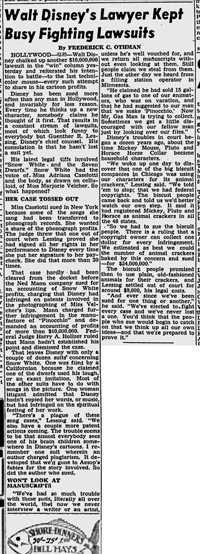Though the work that animators create is often exhilarating, the actual process of animating, which involves sitting at a desk for hours at a time, is not particularly interesting to the general public. In the past, when studio publicity departments were tasked with creating publicity stills of animators, they often posed animators making an expression in front of their mirror while drawing a character with a similar expression. The mirror, it turns out, was not just useful to the animator’s own process but also to the photographer who wanted to compose a dynamic image of the animator at work. It never occurred to me what a common motif this was until I collected a few of them on Instagram a few days ago. Looking at more recent publicity shots of 2D animators, especially from the 1980s and ’90s, the animator-making-an-expression-in-a-mirror publicity shot was largely phased out in favor of a more generic pose of an animator drawing at a desk, looking at the camera while drawing and flipping, or the unnatural pose of holding a maquette while drawing. Enjoy this collection of legendary animators hard at work creating some classic characters:
Add a CommentViewing: Blog Posts Tagged with: Fred Moore, Most Recent at Top [Help]
Results 1 - 8 of 8
Blog: Cartoon Brew (Login to Add to MyJacketFlap)
JacketFlap tags: Woolie Reitherman, Ken Harris, Carlo Vinci, Charles Nichols, Irv Spence, Norm Ferguson, Animators, Ward Kimball, Ollie Johnston, Fred Moore, Add a tag
Blog: Cartoon Brew (Login to Add to MyJacketFlap)
JacketFlap tags: Disney, Animators, Mickey Mouse, Educational, Fred Moore, Pluto's Judgement Day, Add a tag
Among the most important things an animator must keep in mind when animating is making sure that drawings read clearly to the viewer. By using strong keys, solid staging, and clear silhouettes, the audience can understand the actions that a character performs onscreen.
Legendary Disney animator Fred Moore, known for his broad yet overwhelmingly appealing drawings, took that idea one step further in his animation. Not only did he have strong silhouettes in his keys, but he ensured that his animation had strong silhouettes throughout a scene. The clarity of his silhouettes remained even in the breakdowns and inbetweens.
In this scene from Pluto’s Judgement Day, Moore animates Mickey struggling to regain order after Pluto, covered in mud, chases a kitten into his house and wrecks havoc:
Despite how frantically Mickey is moving around in this shot, as well as being obscured by Pluto and the mud effects, his action is still clear because Moore kept the silhouettes intact from drawing to drawing for most of the scene. The negative space between Mickey’s limbs, head and ears as well as the kitten’s paws, ears and tail help bring out the poses. Further, he exaggerates his poses for readability, especially during anticipations. Moore also uses strong arcs, both in Mickey’s torso and his arms, to visually guide the viewer where the actions is going next.
I went over the whole scene and blacked out Mickey and the kitten to show their silhouettes more clearly:
Disney story artist Mark Kennedy talks about silhouettes in greater detail on his blog.
Add a CommentBlog: Cartoon Brew (Login to Add to MyJacketFlap)
JacketFlap tags: Bob Clampett, Shamus Culhane, Fred Moore, Frank Tashlin, Milt Kahl, Tex Avery, Preston Blair, Dick Kinney, Pat Matthews, Rod Scribner, Animators, World War II, Add a tag

Cartoon women are inherently difficult subjects for the animator for the reason that animation demands caricature and comedy, which are concepts inconsistent with femininity, grace and sensuality. The result is that when animators create female leads, they tend to de-emphasize cartoon qualities and accentuate realistic mannerisms and behaviors.
There was a brief moment in animation history when funny and sexy female characters were encouraged though, and that era coincided roughly with World War II. Some historians, like John Costello, have argued that the war represented the true beginnings of the sexual revolution in the United States. During the early-1940s, sexual imagery gained new visibility and cultural acceptance. Young soldiers lusted after Betty Grable and Rita Hayworth pin-ups, while reading Milton Caniff’s comic Male Call and decorating their bombers with provocative nose art. Within this liberal environment, Hollywood directors and animators took advantage of the opportunity to explore creative new ways of portraying the female character in animation.

A handful of animators, notably Pat Matthews, Preston Blair, Rod Scribner, Fred Moore, and Milt Kahl, became known for their ability to handle women characters that were true cartoon creations. Still, there were limited opportunities to animate such characters, and it wasn’t uncommon for animators to use male characters in drag as a substitute for the female, such as Daffy Duck’s striptease in The Wise Quacking Duck (1943), animated by Art Babbitt.
The sexy cartoon female occasionally appeared in animation after the war, but by and large, the industry began to favor a blander and less cartoon-influenced style. By the early-1960s, the average cartoon female in Hollywood animation had become so unappealing that Rocky and Bullwinkle co-creator Bill Scott quipped, “The way women are drawn in our business today, one would assume all the artists are fags.”
The following selection of animated films illustrate some of the various approaches to the animated female character during the World War II period:
“Eatin’ on the Cuff” or The Moth who Came to Dinner (Warner Bros, Bob Clampett, 1942)
Coal Black and de Sebben Dwarfs (Warner Bros, Bob Clampett 1943)
Red Hot Riding Hood (MGM, Tex Avery, 1943)
Abou Ben Boogie (Walter Lantz Prod, Shamus Culhane, 1944)
Plane Daffy (Warner Bros, Frank Tashlin, 1944)
Duck Pimples (Disney, Jack Kinney, 1945)
Blog: Cartoon Brew (Login to Add to MyJacketFlap)
JacketFlap tags: Disney, Classic, Ward Kimball, Fred Moore, Tom Oreb, Bill Berg, Ken Walker, Add a tag
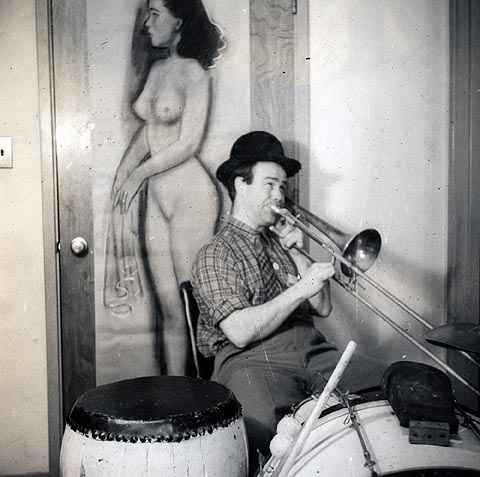
No matter how many books one reads about classic Disney animation, it’s difficult to imagine the day-to-day life of artists during the studio’s Golden Age. Obviously, we know the artists worked on films like Snow White and the Seven Dwarfs, Pinocchio, Dumbo, Fantasia and Bambi. And by most accounts, they had a pretty good time doing it. But what was the work environment like on any given day?
While I was writing my upcoming biography of Disney animator and director Ward Kimball (pictured up top), I was granted access to the personal journals that Ward kept during the 1940s. His writings provided a unique and unprecedented look into the day-to-day life at the Disney studio through the eyes of one of the studio’s most creative and gifted artists.
The journal entry reprinted below is from exactly seventy years ago today—August 7, 1942. There was a World War raging at the time and the studio’s regular output had been interrupted by the urgent demand for military training films and other war-themed shorts, like Education for Death, which Kimball was animating at the time. Here is Ward’s record of that warm August day in Burbank, California:
Friday, August 7, 1942
At the studio a kid – Kenny Walker— brought in 2 quarts of whiskey to celebrate his joining the Navy. We said, “Let’s wait til this afternoon.” “No,” says Fred [Moore], “now!” I mixed a big one with Coke at 11am. Got nice and glowy for our noon hour jam session. Tom [Oreb] really beat it out.I hit every note made for the trombone—My! My! We knocked the pants off of “Jingle Bells,” etc. At 1:00 the boys were really hitting it up—no work—at 2:00 we played records with everyone in the unit beating on something! I blew my trombone—[Jack] Whitaker his bass! People came from the far corners of the studio to hear us. What a din.
The 2 qts were gone—I counted 6 empties in the hallway. Bill Berg—separated from his wife 6 mo. was going out on his 1st date tonight—”Going to get some” he said—but, alas! He had too much—passed out cold—the nurse had to give him shots—then carried him to his car. Wow! Just like old times—wine, song, no women.
The moral of the story: if you run an animation studio, always have a nurse on staff.
Cartoon Brew |
Permalink |
3 comments |
Post tags: Bill Berg, Fred Moore, Ken Walker, Tom Oreb
Blog: Cartoon Brew (Login to Add to MyJacketFlap)
JacketFlap tags: Disney, Ideas/Commentary, Walt Disney, Bill Peet, Frank Thomas, Ward Kimball, Ollie Johnston, Ub Iwerks, Shamus Culhane, Charles Mintz, Fred Moore, Marc Davis, Art Babbitt, Bill Tytla, Margaret Winkler, Roy O. Disney, Add a tag
Who needs the Disney Company! We’ve already got the movie poster for a biopic about Walt Disney so we may as well go ahead and cast the movie. That’s what Cartoon Brew reader Ron did in the comments section yesterday. Below are his novel casting choices for the likes of Roy Disney, Ub Iwerks, Margaret Winkler, Fred Moore, Bill Tytla, Art Babbitt, Frank Thomas, Ollie Johnston and others. Share your dream cast in the comments.
Roy O. Disney :: Joel David Moore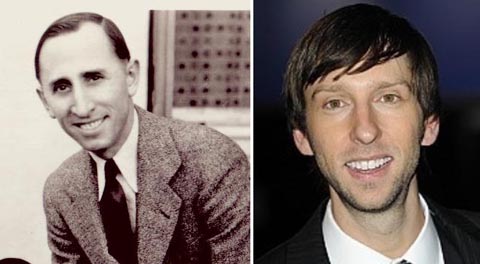
Ub Iwerks :: Tarran Killam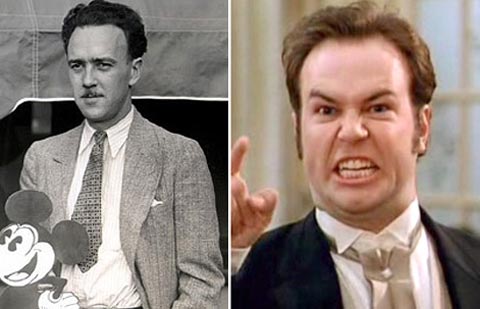
Charles Mintz :: Jeremy Piven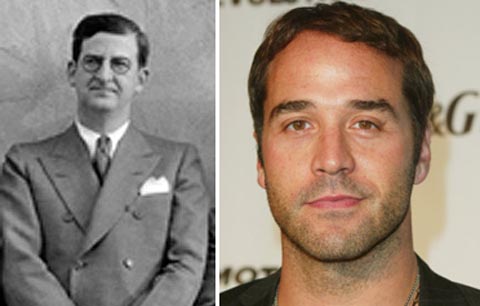
Margaret Winkler :: Samantha Morton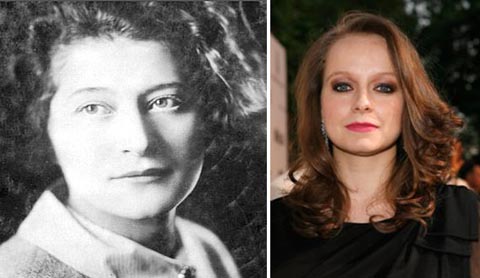
Fred Moore :: Sam Huntington
Ward Kimball :: Chris Diamantopoulos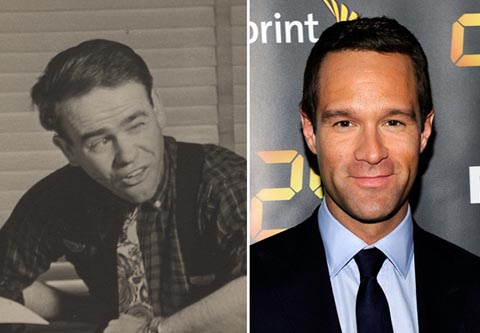
Bill Tytla :: Kevin Dillon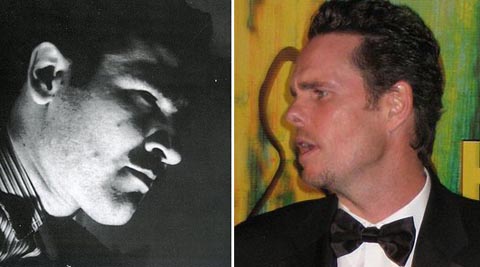
Art Babbitt :: Don Swayze (Apparently, Swayze has already committed to this non-existent film. Ron wrote in the comments, “I’ve met him in person and he looks just like a young Art Babbitt. I told him that in fact and said he should try to play Art Babbitt in a biopic. He seemed open to the idea once I explained who Art Babbitt was and his contribution to history.”)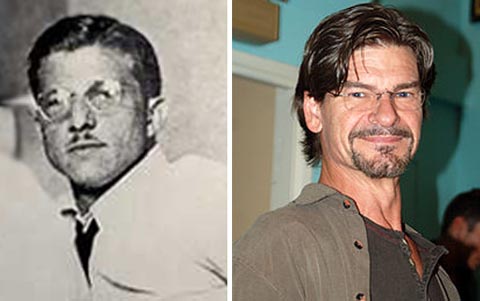
Marc Davis :: David Cross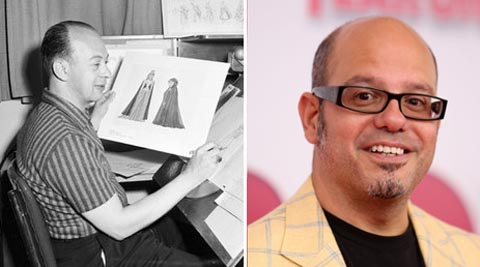
Frank Thomas and Ollie Johnston :: Jason Bateman and Jon Cryer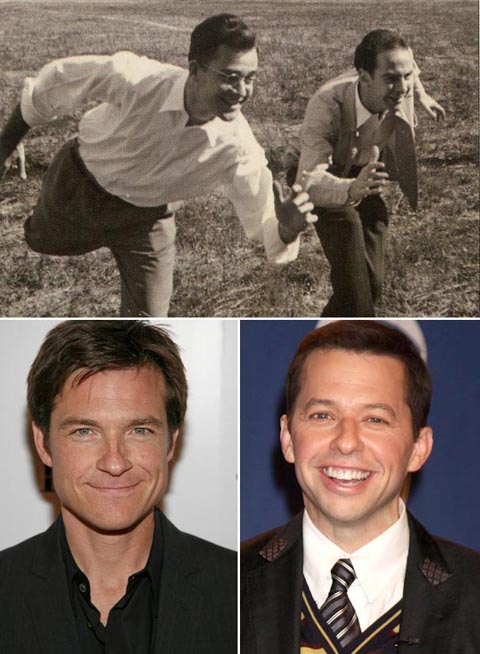
Shamus Culhane :: Kevin Connolly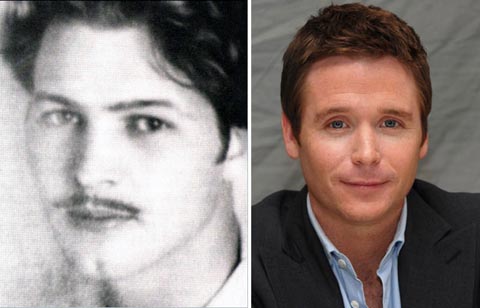
Bill Peet :: Topher Grace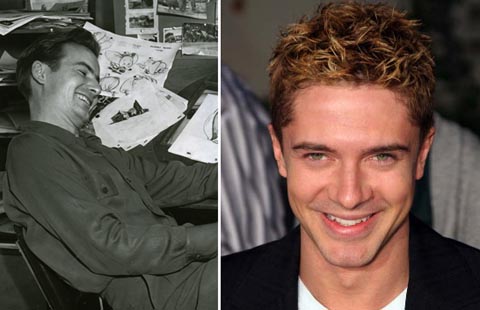
Cartoon Brew | Permalink | No comment | Post tags: Art Babbitt, Bill Peet, Bill Tytla, Charles Mintz, Frank Thomas, Fred Moore, Marc Davis, Margaret Winkler, Ollie Johnston, Roy O. Disney,
Add a CommentBlog: Cartoon Brew (Login to Add to MyJacketFlap)
JacketFlap tags: Disney, Ideas/Commentary, Classic, Walt Disney, Fred Moore, Gunther Lessing, Ham Luske, Add a tag
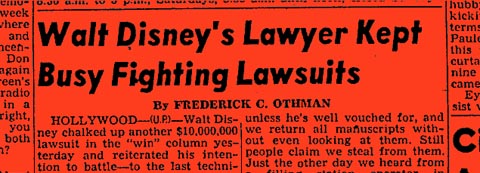
It’s no secret that the Walt Disney Company is fiercely protective of its intellectual property, but the law works both ways, and they’ve been accused of wrongdoing almost from the moment that Walt’s company became successful. While researching my upcoming biography of Ward Kimball, I found a reference to a “Mann lawsuit” in his notes from 1940. Ward wrote about how animator Fred Moore had been questioned by Mann’s attorney’s, as well as how animator Ham Luske had testified on the stand.
I became curious to learn more about what the lawsuit was all about. The plaintiff was Ned Herbert Mann, a well respected veteran special effects artist who had started his career working with the production designer William Cameron Menzies on The Thief of Bagdad (1924). Mann believed that he had patented an animation process back in 1934 that was similar to Disney’s and he was trying to prove that Walt had traced the mouths of characters off of photostats while producing Snow White. The Disney company was eventually able to prove that the claim was completely baseless and the judge dismissed the case.
The only information I could find online regarding the case was an article from the St. Petersburg Times from June 29, 1940. You can read the entire article below. The article is fascinating, not just for the information it provides about the Mann case, but also because it lists some of the dozens of other cases filed against Disney at the time. According to the Disney studio’s attorney Gunther Lessing, “The trouble seems to be that almost everybody sees one of his brain children somewhere in Disney’s cartoons.” Some of the cases against Disney at the time included:
* Adriana Caselotti, the voice of the character Snow White, had sued Disney because some of the songs she sang had been released as records, and she wanted a share of the record profits. The case was thrown out when Lessing produced a document that proved “she had signed all her rights in her performance to Disney every time she put her signature to her paycheck.”
* A guy in California filed a lawsuit because he claimed that one of the dwarfs used his laugh or “an exact imitation.”
* A woman filed a lawsuit which claimed that while Disney hadn’t copied her words or music, he had infringed on the spiritual feeling of her work.
* A gas station operator in Minnesota claimed he had sold 15 gallons of gas to an animator who was on vacation, and that he had suggested to the artist that the Disney studio produce Pinocchio.
The article also talks about how Disney had sued a biscuit company that was making unauthorized Mickey, Pluto and Horace Horsecollar animal crackers. The Disney company sued for $24 million dollars, but eventually settled out of court for $8,000.
Here’s the entire piece:
Cartoon Brew | Permalink | No comment | Post tags: Fred Moore, Gunther Lessing, Ham Luske,
Add a CommentBlog: Cartoon Brew (Login to Add to MyJacketFlap)
JacketFlap tags: Fred Moore, Milt Kahl, Dick Shaw, Jack Kinney, Marc Davis, Virgil Partch, Shorts, Disney, Add a tag
Let’s celebrate Halloween with the creepiest Disney short ever made: Jack Kinney’s Duck Pimples. It’s quite unlike any of Kinney’s Goofy shorts from the same period, not to mention unlike any short ever produced at Disney. The weirdness may be attributed to the writing team of Dick Shaw and weirdo-genius Virgil Partch, who were parodying radio crime/noir dramas, but veered off into some wildly surreal territory. It’s not exactly a great cartoon, but it’s entertaining, which I can’t say for most other Disney shorts. The animation is top-drawer work, and the human character designs are big fun. The effect of Donald’s hallucinatory dream is enhanced by the backgrounds that abruptly change each time a new character appears in the film.
The biggest mystery in this whodunnit is who’s responsible for the animation of Pauline, which is one of the finest pieces of cartoony female animation this side of Preston Blair. Milt Kahl is the most likely candidate if we look at the credits, but Marc Davis and Fred Moore have both been credited as working on the cartoon too (see Graham Webb’s Animated Film Encyclopedia). Disney didn’t use a strict unit system in the 1940s like other studios; usually whichever animators had downtime would work on a short, so it’s conceivable that Kahl, Moore and Davis all contributed to Pauline’s animation. Now that’s a scary amount of talent!
Cartoon Brew: Leading the Animation Conversation |
Permalink |
No comment |
Post tags: Dick Shaw, Fred Moore, Jack Kinney, Marc Davis, Milt Kahl, Virgil Partch
Blog: Cartoon Brew (Login to Add to MyJacketFlap)
JacketFlap tags: Lee Blair, UPA, Fred Moore, First Motion Picture Unit, FMPU, Freddie Moore, Disney, Classic, Add a tag
Here are six good and rare animation-related clips I discovered on Critical Past, a stock footage house that specializes in films from US government agencies.

Not Walt Disney’s finest moment: his 1947 testimony in front of the House Un-American Activities committee HERE and HERE.
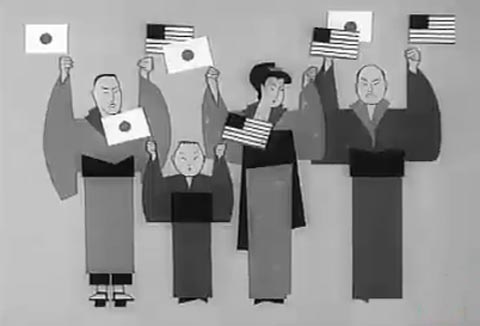
Japan, earthquakes and animation from 1945: “A Few Quick Facts: Japan” was produced by UPA for the Army-Navy Screen Magazine.
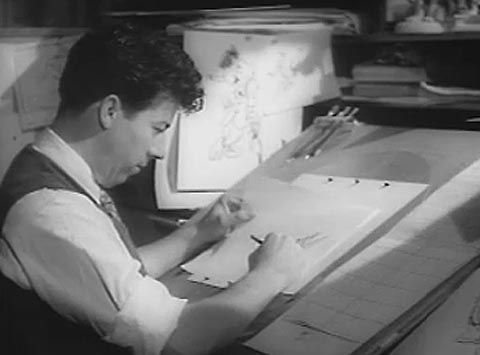
Animator Fred Moore working at his desk (or at least pretending to work). Over one minute of Freddie footage from 1943. Does any other footage of Moore animating exist?
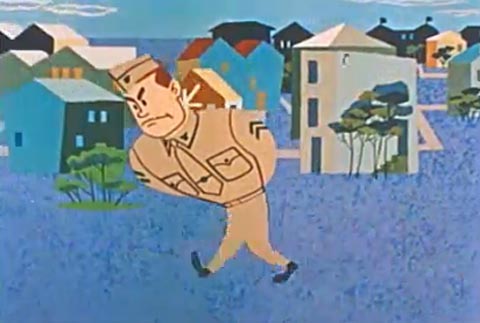
A clip from a 1958 military film produced by New York studio Film Graphics Inc, which was co-owned by Lee Blair (Mary Blair’s husband).
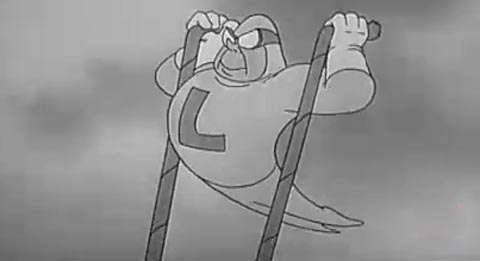
Footage of animators working in the FMPU (First Motion Picture Unit), plus a clip from a FMPU training film. I see Joe Smith and Gus Arriola in this clip, as well as the back of Rudy Larriva and Jules Engel’s heads (I think).
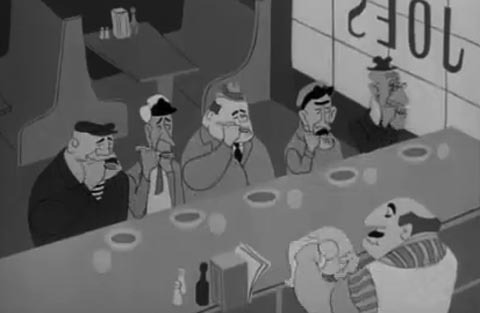
Disorientation Crashes, a handsome UPA short produced for the US Navy’s “Flight Safety” series. Most likely designed by Bill Hurtz and animated by Bobe Cannon and Willis Pyle.
Cartoon Brew: Leading the Animation Conversation |
Permalink |
No comment |
Post tags: First Motion Picture Unit, FMPU, Fred Moore, Freddie Moore, Lee Blair, UPA



